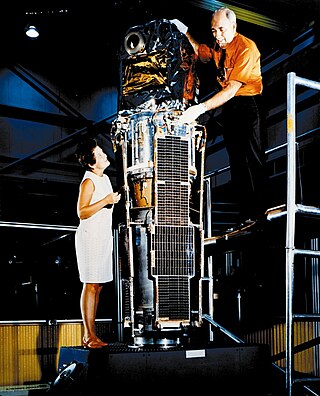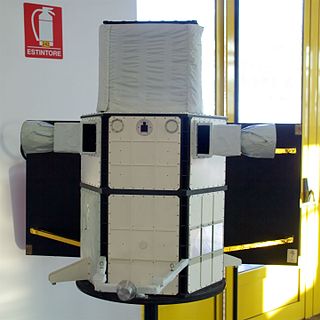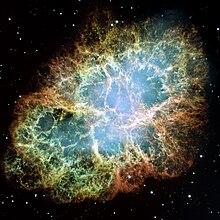
X-ray astronomy is an observational branch of astronomy which deals with the study of X-ray observation and detection from astronomical objects. X-radiation is absorbed by the Earth's atmosphere, so instruments to detect X-rays must be taken to high altitude by balloons, sounding rockets, and satellites. X-ray astronomy uses a type of space telescope that can see x-ray radiation which standard optical telescopes, such as the Mauna Kea Observatories, cannot.

The Chandra X-ray Observatory (CXO), previously known as the Advanced X-ray Astrophysics Facility (AXAF), is a Flagship-class space telescope launched aboard the Space ShuttleColumbia during STS-93 by NASA on July 23, 1999. Chandra was sensitive to X-ray sources 100 times fainter than any previous X-ray telescope, enabled by the high angular resolution of its mirrors. Since the Earth's atmosphere absorbs the vast majority of X-rays, they are not detectable from Earth-based telescopes; therefore space-based telescopes are required to make these observations. Chandra is an Earth satellite in a 64-hour orbit, and its mission is ongoing as of 2024.

BeppoSAX was an Italian–Dutch satellite for X-ray astronomy which played a crucial role in resolving the origin of gamma-ray bursts (GRBs), the most energetic events known in the universe. It was the first X-ray mission capable of simultaneously observing targets over more than 3 decades of energy, from 0.1 to 300 kiloelectronvolts (keV) with relatively large area, good energy resolution and imaging capabilities. BeppoSAX was a major programme of the Italian Space Agency (ASI) with the participation of the Netherlands Agency for Aerospace Programmes (NIVR). The prime contractor for the space segment was Alenia while Nuova Telespazio led the development of the ground segment. Most of the scientific instruments were developed by the Italian National Research Council (CNR) while the Wide Field Cameras were developed by the Netherlands Institute for Space Research (SRON) and the LECS was developed by the astrophysics division of the European Space Agency's ESTEC facility.

XMM-Newton, also known as the High Throughput X-ray Spectroscopy Mission and the X-ray Multi-Mirror Mission, is an X-ray space observatory launched by the European Space Agency in December 1999 on an Ariane 5 rocket. It is the second cornerstone mission of ESA's Horizon 2000 programme. Named after physicist and astronomer Sir Isaac Newton, the spacecraft is tasked with investigating interstellar X-ray sources, performing narrow- and broad-range spectroscopy, and performing the first simultaneous imaging of objects in both X-ray and optical wavelengths.

Uhuru was the first satellite launched specifically for the purpose of X-ray astronomy. It was also known as the X-ray Explorer Satellite, SAS-A, SAS 1, or Explorer 42. The observatory was launched on 12 December 1970 into an initial orbit of about 560 km apogee, 520 km perigee, 3 degrees inclination, with a period of 96 minutes. The mission ended in March 1973. Uhuru was a scanning mission, with a spin period of ~12 minutes. It performed the first comprehensive survey of the entire sky for X-ray sources, with a sensitivity of about 0.001 times the intensity of the Crab nebula.

The Compton Gamma Ray Observatory (CGRO) was a space observatory detecting photons with energies from 20 keV to 30 GeV, in Earth orbit from 1991 to 2000. The observatory featured four main telescopes in one spacecraft, covering X-rays and gamma rays, including various specialized sub-instruments and detectors. Following 14 years of effort, the observatory was launched from Space Shuttle Atlantis during STS-37 on April 5, 1991, and operated until its deorbit on June 4, 2000. It was deployed in low Earth orbit at 450 km (280 mi) to avoid the Van Allen radiation belt. It was the heaviest astrophysical payload ever flown at that time at 16,300 kilograms (35,900 lb).

The Rossi X-ray Timing Explorer (RXTE) was a NASA satellite that observed the time variation of astronomical X-ray sources, named after physicist Bruno Rossi. The RXTE had three instruments — an All Sky Monitor, the High-Energy X-ray Timing Experiment (HEXTE) and the Proportional Counter Array. The RXTE observed X-rays from black holes, neutron stars, X-ray pulsars and X-ray bursts. It was funded as part of the Explorer program, and was also called Explorer 69.

Reuven Ramaty High Energy Solar Spectroscopic Imager was a NASA solar flare observatory. It was the sixth mission in the Small Explorer program (SMEX), selected in October 1997 and launched on 5 February 2002, at 20:58:12 UTC. Its primary mission was to explore the physics of particle acceleration and energy release in solar flares.

The Crab Pulsar is a relatively young neutron star. The star is the central star in the Crab Nebula, a remnant of the supernova SN 1054, which was widely observed on Earth in the year 1054. Discovered in 1968, the pulsar was the first to be connected with a supernova remnant.

HEAO-1 was an X-ray telescope launched in 1977. HEAO-1 surveyed the sky in the X-ray portion of the electromagnetic spectrum, providing nearly constant monitoring of X-ray sources near the ecliptic poles and more detailed studies of a number of objects by observations lasting 3–6 hours. It was the first of NASA's three High Energy Astronomy Observatories, HEAO 1, launched August 12, 1977 aboard an Atlas rocket with a Centaur upper stage, operated until 9 January 1979. During that time, it scanned the X-ray sky almost three times

An X-ray telescope (XRT) is a telescope that is designed to observe remote objects in the X-ray spectrum. X-rays are absorbed by the Earth's atmosphere, so instruments to detect X-rays must be taken to high altitude by balloons, sounding rockets, and satellites.

AGILE was an X-ray and gamma ray astronomical satellite of the Italian Space Agency (ASI). Launched in 2007, it de-orbited in February 2024.

The International Astrophysical Observatory "GRANAT", was a Soviet space observatory developed in collaboration with France, Denmark and Bulgaria. It was launched on 1 December 1989 aboard a Proton rocket and placed in a highly eccentric four-day orbit, of which three were devoted to observations. It operated for almost nine years.

The last of NASA's three High Energy Astronomy Observatories, HEAO 3 was launched 20 September 1979 on an Atlas-Centaur launch vehicle, into a nearly circular, 43.6 degree inclination low Earth orbit with an initial perigeum of 486.4 km. The normal operating mode was a continuous celestial scan, spinning approximately once every 20 min about the spacecraft z-axis, which was nominally pointed at the Sun. Total mass of the observatory at launch was 2,660.0 kilograms (5,864.3 lb).

The Small Astronomy Satellite 3 was a NASA X-ray astronomy space telescope. It functioned from May 7, 1975 to April 1979. It covered the X-ray range with four experiments on board. The satellite, built by the Johns Hopkins University Applied Physics Laboratory (APL), was proposed and operated by MIT's Center for Space Research (CSR). It was launched on a Scout vehicle from the Italian San Marco launch platform near Mombasa, Kenya, into a low-Earth, nearly equatorial orbit. It was also known as Explorer 53, as part of NASA's Explorer program.

A gamma ray, also known as gamma radiation (symbol
γ
), is a penetrating form of electromagnetic radiation arising from the radioactive decay of atomic nuclei. It consists of the shortest wavelength electromagnetic waves, typically shorter than those of X-rays. With frequencies above 30 exahertz (3×1019 Hz) and wavelength less than 10 picometer (1×10−11 m) gamma ray photons have the highest photon energy of any form of electromagnetic radiation. Paul Villard, a French chemist and physicist, discovered gamma radiation in 1900 while studying radiation emitted by radium. In 1903, Ernest Rutherford named this radiation gamma rays based on their relatively strong penetration of matter; in 1900 he had already named two less penetrating types of decay radiation (discovered by Henri Becquerel) alpha rays and beta rays in ascending order of penetrating power.

Gamma-ray astronomy is the astronomical observation of gamma rays, the most energetic form of electromagnetic radiation, with photon energies above 100 keV. Radiation below 100 keV is classified as X-rays and is the subject of X-ray astronomy.
X-ray emission occurs from many celestial objects. These emissions can have a pattern, occur intermittently, or as a transient astronomical event. In X-ray astronomy many sources have been discovered by placing an X-ray detector above the Earth's atmosphere. Often, the first X-ray source discovered in many constellations is an X-ray transient. These objects show changing levels of X-ray emission. NRL astronomer Dr. Joseph Lazio stated: " ... the sky is known to be full of transient objects emitting at X- and gamma-ray wavelengths, ...". There are a growing number of recurrent X-ray transients. In the sense of traveling as a transient, the only stellar X-ray source that does not belong to a constellation is the Sun. As seen from Earth, the Sun moves from west to east along the ecliptic, passing over the course of one year through the twelve constellations of the Zodiac, and Ophiuchus.

Explorer 45 was a NASA satellite launched as part of Explorer program. Explorer 45 was the only one to be released from the program Small Scientific Satellite.

The X-ray Polarimeter Satellite (XPoSat) is an Indian Space Research Organisation (ISRO) manufactured space observatory to study polarisation of cosmic X-rays. It was launched on 1 January 2024 on a PSLV rocket, and it has an expected operational lifespan of at least five years.


















